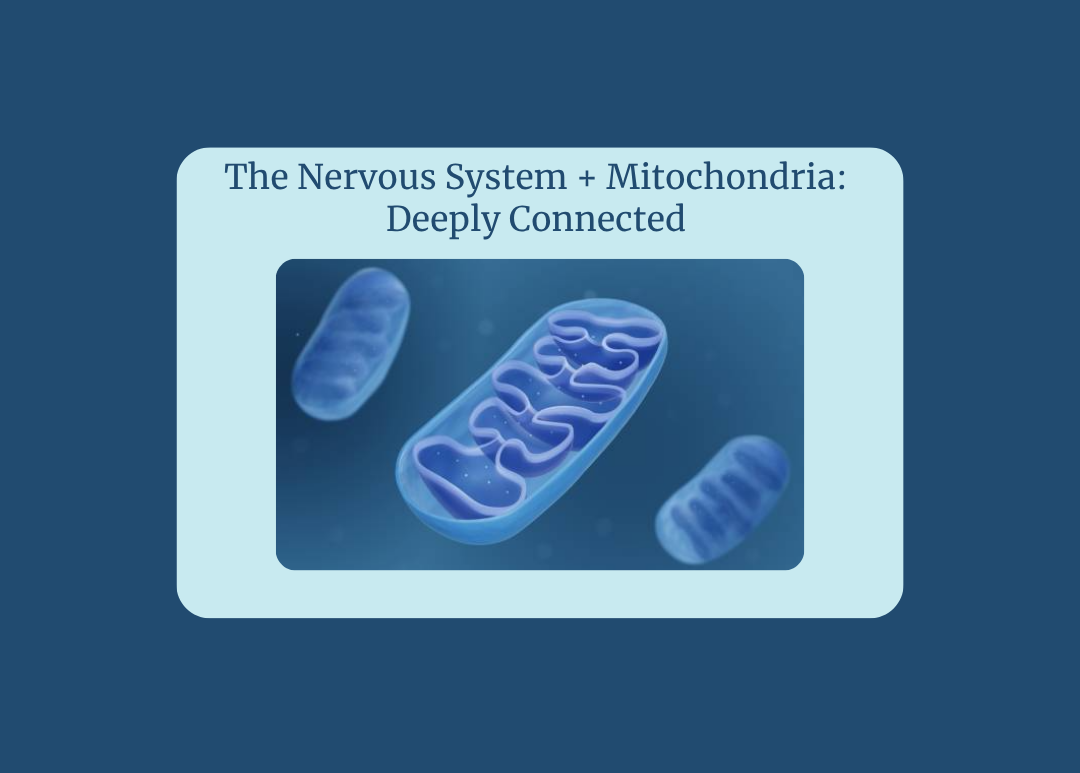Optimizing Your Mitochondria for Energy, Aging + Healing
When most people think about improving their health, they focus on things like diet, exercise, or even stress management. But deep beneath the surface—at the cellular level—there's a microscopic powerhouse responsible for nearly every process your body performs: the mitochondria.
If you want more energy, better brain function, improved healing, and even longevity, it all starts with supporting these tiny energy producers inside your cells.
In this blog, we’ll explore exactly what mitochondria are, why they matter, how they tie into your nervous system, and most importantly — what you can do every single day to boost mitochondrial health and take control of your long-term vitality.
What Are Mitochondria?
You may remember the phrase from biology class: The mitochondria are the powerhouse of the cell. And while that sentence might sound simple, the truth is profound.
Mitochondria are specialized organelles found inside almost every cell in your body. Their primary job is to take nutrients from the food you eat (carbohydrates, fats, and proteins) and convert them into adenosine triphosphate (ATP) — the molecular fuel that powers every process in your body.
Breathing? ATP.
Thinking? ATP.
Repairing tissue? ATP.
Regulating your heartbeat? ATP.
Without mitochondria doing their job efficiently, your body can’t create enough ATP to keep up with the demands of life. And when mitochondrial function starts to falter, we see wide-ranging consequences like:
- Chronic fatigue
- Brain fog and cognitive decline
- Accelerated aging
- Hormonal imbalances
- Poor recovery
- Neurodegenerative diseases
- Increased inflammation
In fact, numerous chronic diseases—including Alzheimer’s, Parkinson’s, type 2 diabetes, cardiovascular disease, and even some cancers—have been linked to mitochondrial dysfunction.
The Nervous System + Mitochondria: Deeply Connected
Your nervous system and mitochondria are intricately linked.
Every time your nervous system shifts into a fight-or-flight state (sympathetic dominance) — whether from emotional stress, toxins, poor sleep, or trauma — it signals your body to burn through energy rapidly, increasing mitochondrial demand.
But constant stress with insufficient recovery eventually exhausts your mitochondria. When that happens, your cells shift into survival mode, producing less ATP and more free radicals (oxidative stress), which leads to inflammation, cellular damage, and accelerated aging.
On the flip side, when your nervous system enters parasympathetic mode (rest, digest, heal) — through breathwork, meditation, movement, or neural integration work at REV — you allow mitochondria to repair, replicate, and optimize energy output.
In other words, a regulated nervous system creates the best environment for mitochondrial health and cellular healing.
Why Mitochondria Decline With Age
As we age, mitochondrial function naturally declines. This drop in efficiency is one reason many people experience:
- Slower metabolism
- Decreased endurance
- Less resilience to stress
- Poorer cognitive function
- Increased disease risk
One study from the Journal of Clinical Investigation showed that mitochondrial content and efficiency drop significantly by the time we reach 40–50 years old. And much of this decline is preventable with intentional lifestyle changes.
Supporting mitochondria isn’t just about “feeling better” — it’s about preserving healthspan (the years of life spent in good health) and reducing the risk of chronic disease.
How to Naturally Boost Mitochondrial Function
Here’s the good news: mitochondria are remarkably adaptable. Your body can actually create more mitochondria per cell (a process called mitochondrial biogenesis) when you stimulate them properly. Here are science-backed ways to help your mitochondria thrive:
- Exercise (Especially HIIT + Resistance Training): Physical activity is one of the most powerful triggers for mitochondrial biogenesis. High-intensity interval training (HIIT) has been shown to increase mitochondrial content in muscle cells by up to 50%. Strength training also stimulates mitochondrial growth while improving metabolic flexibility. Movement creates mild stress signals (called hormesis) that tell your cells to adapt, grow stronger, and produce more energy.
- Intermittent Fasting + Time-Restricted Eating: Periods of fasting trigger mitochondrial cleanup through a process called autophagy — where damaged cellular components are recycled to make way for stronger, healthier mitochondria. This doesn’t require extreme fasting. Even simple daily time-restricted eating (like a 12–14 hour overnight fast) can provide benefits for mitochondrial function and insulin sensitivity.
- Breathwork + Parasympathetic Activation: Mitochondria thrive when your nervous system is calm and regulated. Deep diaphragmatic breathing, box breathing, and breath-focused meditations signal your body to shift into parasympathetic mode — creating the perfect environment for mitochondrial healing, lowering inflammation, and improving oxygen delivery.
- Quality Sleep: Deep, restorative sleep is when your mitochondria do much of their repair work. Sleep deprivation, on the other hand, directly impairs mitochondrial efficiency and increases oxidative stress. Create a dark and cool sleep environment, aiming for 7-9 hours of quality sleep per night, and limiting blue light exposure before bed.
- Nutritional Support (Key Nutrients): Certain nutrients are absolutely critical for mitochondrial health. While many of these can be consumed through a nutrient-dense diet, some individuals may benefit from additional supplementation depending on their unique needs.
- Magnesium — essential cofactor for ATP production
- Coenzyme Q10 (CoQ10) — key for electron transport chain function
- L-Carnitine — supports fat transport into mitochondria for fuel
- B Vitamins (especially B2, B3) — vital for cellular energy pathways
- Alpha-Lipoic Acid — antioxidant support for mitochondria
- Minimize Toxins + Oxidative Stress: Mitochondriaare highly sensitive to environmental toxins such as mold, heavy metals, pesticides, EMF exposure, and chronic alcohol use. Reducing toxic load allows mitochondria to function more optimally and prevents long-term cellular damage.
- Sauna Therapy + Infrared Light: One of the most effective and sustainable ways to support mitochondrial health — without adding physical stress to the body — is through regular sauna use. Heat exposure (especially infrared sauna therapy) creates a mild, controlled hormetic stress that stimulates mitochondrial biogenesis, boosts cellular repair, and enhances detoxification pathways. Here's what the research shows:
- Repeated sauna use can increase mitochondrial numbers, improve ATP production, and enhance overall energy metabolism.
- Heat exposure activates heat shock proteins (HSPs), which help protect mitochondrial proteins from damage, improve protein folding, and support cellular longevity.
- Regular sauna use has been associated with reduced risk of cardiovascular disease, dementia, and all-cause mortality according to long-term population studies from Finland.
In addition, sauna sessions promote deep parasympathetic activation — allowing the nervous system to regulate, release tension, and support whole-body healing. Infrared saunas may offer even more targeted mitochondrial benefits, as infrared wavelengths penetrate deeper into tissues and directly influence mitochondrial photoreceptors like cytochrome c oxidase.
Bonus Tip: Sunlight
Regular exposure to natural sunlight — particularly early morning light — helps regulate your circadian rhythm and triggers beneficial mitochondrial responses.
Mitochondria: The Root of Resilience
At its core, mitochondrial health is about giving your cells the ability to adapt. Adapt to stress. Adapt to healing. Adapt to the demands of daily life.
By strengthening your mitochondria, you build true resilience at the most foundational level of your being — creating more energy, sharper cognition, better mood, stronger immunity, and improved long-term vitality.
And while no single practice is magic on its own, small consistent habits compounded over time create massive shifts in your energy production and cellular healing.
Key Takeaways:
- Mitochondria are central to your energy, healing, and aging process.
- You have more control than you think — through simple, daily lifestyle strategies.
- A regulated nervous system creates the best environment for mitochondrial health - this is why gentle, holistic chiropractic is so powerful.
Dive Deeper:
Want to explore more topics on subconscious healing and holistic health? Check out our video resources and join our REV community online for more tools and practices that elevate your health and enhance your nervous system integration.
Phone: (423) 713 - 7390 / Schedule Online: click here
Disclaimer: This blog is meant for informational & entertainment purposes only, and should not be taken as medical advice. Please consult your healthcare practitioner before making any changes or if you have any questions regarding information provided.











